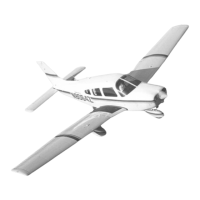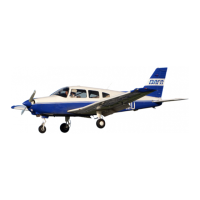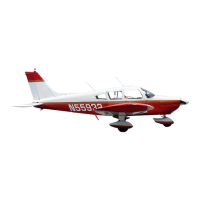PIPER AIRCRAFT, INC.
PA-28-161, WARRIOR III
MAINTENANCE MANUAL
PAGE 1
Nov 30/06
3D17
32-10-00
MAIN GEAR
1. Main Gear Oleo
A. Disassembly (Refer to Figure 1.)
The main gear axle (15) and piston tube assembly (14) may be removed from the cylinder housing (7)
with the gear removed from or installed on the airplane.
(1) Place the airplane on jacks. (Refer to Jacking, Section 7-10-00.)
(2) Place a drip pan under the main gear to catch spillage.
(3) The gear axle and piston tube assembly may be removed by the following procedure:
(a) Remove the air from the oleo chamber by depressing the air valve core pin found in the
inspection hole on top of the wing. After the pressure in the oleo chamber has diminished,
remove the valve core pin, attach a small hose to air valve, and drain the fluid by slowly
compressing the piston tube. If it is desirable to extract more fluid from the chamber,
remove the filler plug, insert a siphon hose and drain fluid from the upper area of the
housing.
(b) Disconnect the flexible brake line at the elbow on the brake assembly.
(c) Disconnect the torque link assembly by removing any one of the three cotter pins, nuts,
washers and bolts. Note arrangement of the components for reinstallation. Carefully slide
the piston tube from the cylinder housing.
(d) The scraper ring (11) is located inside the lower end of the cylinder housing is removed by
first removing the retainer ring (13), spacer ring (12) and then the scraper ring.
(e) The O-ring seal (10) located just above the scraper ring may be removed by using a
curved wire or spoon shaped tool and inserting it under the ring.
(4) The cylinder head may be removed by cutting the wire and removing the bolts (6 ea.) that
secure the cylinder head (4) in the top of the housing. Remove the assembly from the housing.
B. Cleaning, Inspection, and Repair
(1) Clean all parts with a suitable quick drying type cleaning solvent.
(2) Inspect the landing gear oleo components for the following:
(a) Bearing surfaces of housing for excess wear, corrosion, scratches and overall damage.
(b) Retaining ring for cracks, burrs, etc.
(c) Cylinder tube for corrosion, scratches, nicks, excessive wear and misalignment.
(d) Air valve for operation and general condition.
(e) Orifice plate for hole restriction.
(3) Repair of the oleo is limited to smoothing out minor scratches, nicks and dents, and
replacement of parts.
C. Assembly (Refer to Figure 1.)
(1) If cylinder head was removed, position and secure it with bolts (6 ea.). Torque bolts to 70 in.-lbs.
and safetywire.
(2) Assemble the components of the piston tube (14) on the tube by placing, in order, the retainer
ring (13), spacer ring (12) and scraper ring (11). Insert an O-ring (10) into the annular slot in
the bottom of the housing.
(3) Lubricate the wall of the piston and carefully insert it into the housing being careful not to
damage or dislocate the O-ring in the housing.

